 |
 |
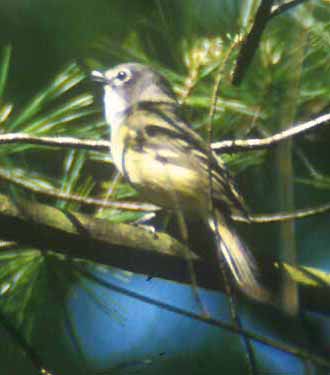 |
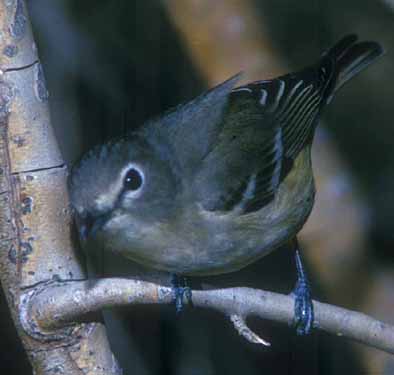 |
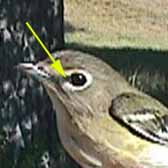
 In 1993 I was doing some research on seabirds at the National Museum in
Washington, D.C., but I also took a look through the Solitary Vireos trying
to find a character that nicely separated the trays of Blue-headed and
Cassin's Vireo. I came upon this potential character: both taxa have a
slate-colored line through the lores that breaks the big white eyering,
but in Blue-headed Vireo (close right) this line is about the same color
as the head while in Cassin's Vireo (far right) this line is much darker
than the gray head, so it "jumps out" at the observer when you look for
it. I mentioned the potential character to Matt Heindel when he was working
on his Birding paper (Heindel 1996) but he didn't think much of
it. Among a suite of characters, that paper tends to emphasize the contrast
between the dark gray head and white throat in Blue-headed versus the the
less obvious contrast between head/throat in auriculars.
In 1993 I was doing some research on seabirds at the National Museum in
Washington, D.C., but I also took a look through the Solitary Vireos trying
to find a character that nicely separated the trays of Blue-headed and
Cassin's Vireo. I came upon this potential character: both taxa have a
slate-colored line through the lores that breaks the big white eyering,
but in Blue-headed Vireo (close right) this line is about the same color
as the head while in Cassin's Vireo (far right) this line is much darker
than the gray head, so it "jumps out" at the observer when you look for
it. I mentioned the potential character to Matt Heindel when he was working
on his Birding paper (Heindel 1996) but he didn't think much of
it. Among a suite of characters, that paper tends to emphasize the contrast
between the dark gray head and white throat in Blue-headed versus the the
less obvious contrast between head/throat in auriculars.
As pointed out in "Frontiers of Bird I.D." posts recently by Martin Reid, there is a far amount of variation in the head/throat contrast within each group. I wonder if my loral mark might also have some value. I have been looking at this when a 'Solitary Vireo' has been encountered over the last decade and I think it works reasonably well. Below are comparatively shots in-hand (both fall birds) and in-the-field (both spring birds I think; Blue-headed is the left bird in each row):
 |
 |
 |
 |
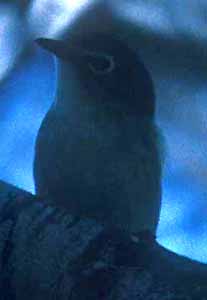
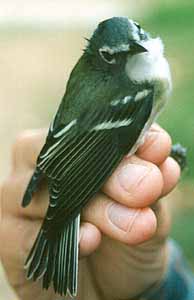 This
seems to me to work so far on the typical Cassin's seen in California and
the few vagrant Blue-headeds I've encountered. There are now 12 records
of Blue-headed Vireo in Monterey County (where I live), all in September-October
and all at coastal vagrant traps. Each one I've seen or read the details
of has been an "obvious" sharply-demarcated, brightly marked bird. Two
of them are shown to the right: one banded at Big Sur Ornith. Lab 28 Sep
1998 (near right; Jim Booker photo) and another that was singing at Big
Sur R. mouth 18 Sep 1993 (far right; Don Roberson photo). The slaty lores
just blend into the slaty-blue head on each bird (and each one has a sharp
white throat/dark head contrast). Incidentally, the 1993 fall bird was
singing a very distinctive song: "faster, with less deliberation between
the 'asking' and 'answering' phrases than local [Cassin's] and sweeter
and more melodious, without any 'burry' quality," according to my field
notes.
This
seems to me to work so far on the typical Cassin's seen in California and
the few vagrant Blue-headeds I've encountered. There are now 12 records
of Blue-headed Vireo in Monterey County (where I live), all in September-October
and all at coastal vagrant traps. Each one I've seen or read the details
of has been an "obvious" sharply-demarcated, brightly marked bird. Two
of them are shown to the right: one banded at Big Sur Ornith. Lab 28 Sep
1998 (near right; Jim Booker photo) and another that was singing at Big
Sur R. mouth 18 Sep 1993 (far right; Don Roberson photo). The slaty lores
just blend into the slaty-blue head on each bird (and each one has a sharp
white throat/dark head contrast). Incidentally, the 1993 fall bird was
singing a very distinctive song: "faster, with less deliberation between
the 'asking' and 'answering' phrases than local [Cassin's] and sweeter
and more melodious, without any 'burry' quality," according to my field
notes.
In hiking to El Triunfo, Chiapas, Mexico, this March our group saw a fair variety of Solitary Vireos. All three taxa (including Plumbeous V. plumbeus) may occur, but presumably Blue-headed is the most common in the cloud forest and tropical woodlands inland and east of the Sierra de Chiapas divide (Howell & Webb 1995). In any event, we (including Greg Lasley, Victor Emanuel, Brad Boyle and others) would often debate some of the birds. My general feeling was that everything I saw on the east slope and up high were Blue-headed Vireos. If that was correct, they showed a fair range of variation in head/throat contrast and overall "brightness." But none had really contrastingly dark lores compared to the head that I have come to expect on Cassin's. [I wonder why the bird Tony Leukering mentioned from Colorado wasn't such a Blue-headed.] Yet most of the Blue-headeds seen were rather obvious.
According to Pyle's banding guide (1997), all adults molt on the breeding grounds and thus should be most fresh and colorful in the fall and early winter, with little or no spring molt. Birds should be the dingiest in summer or late spring. My impression in California has been that there have been a fair number of mistaken claims on "Blue-headed" (esp. in winter) because some observers are not aware of the molt schedule and note that the winter birds look "bright" compared to the summer breeders. My other impression from California is that all the vagrants found by more experienced types are invariably rather obvious birds. This makes me believe we are probably overlooking the "dull end" of Blue-headed here among the bright fall & early winter Cassin's. [I also think some correct Blue-headed claims have been rejected by rarity committees because the written details lack the "pet" marks that some members seem to require, notwithstanding the observer's expertise in general.]
My final thought from this experience is that sometimes we say "only extreme birds" can be identified as vagrants when what is actually meant is that "only typical birds" are identifiable as vagrants. I think most Blue-headeds are straight-forward (at least in fall) because a good chunk of the population is "typical" and bright and contrasty (like the photos on this page). But western populations of Blue-headed may be less obvious and more difficult to confirm when seen as vagrants, and caution is always warranted with such intermediate types.
Literature cited:
Heindel, M. T. 1996. Field identification of the Solitary Vireo complex. Birding 28: 458-471.TOPHowell, S.N.G., and S. Webb. 1995. A Guide of the Birds of Mexico and Northern Central America. Oxford Univ. Press, Oxford.
Pyle, P. 1997. Identification Guide to North American Birds. Slate Creek Press, Bolinas, CA.